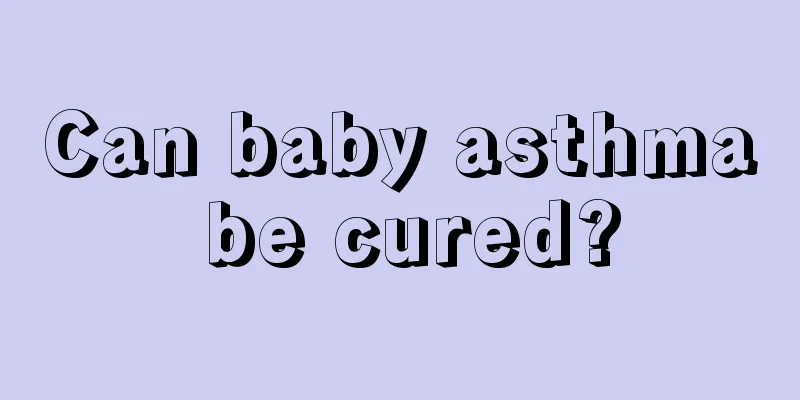Will babies have a fever before getting chickenpox?

|
Babies often have an incubation period when they are infected. In the early stages, they will have symptoms similar to a cold and fever. Many parents will think that their children have caught a cold, but during the treatment process, they will find that their children are beginning to develop chickenpox. This is due to physical reasons in many children. In fact, it is normal for babies to have chickenpox, because many children will be troubled by chickenpox when they are young. As long as you take good care of them and understand the characteristics, they will be fine. Symptoms and signs 1. The incubation period of chickenpox is about 12 to 21 days, with an average of 14 days. The onset is relatively acute, with symptoms in the prodromal period including low or moderate fever, headache, myalgia, joint pain, general malaise, loss of appetite, cough, etc.; a rash appears a few hours after onset, or within 1 to 2 days. The entire course of the disease can be as short as one week or as long as several weeks. 2. Characteristics of varicella rash: There are a large number of varicella rashes, ranging from hundreds to thousands. They usually first appear on the face, scalp, and trunk, and are distributed in a centripetal pattern, with more cases on the hairline, chest and back, fewer on the limbs and face, and occasionally on the palms and soles of the feet. Rashes may also occur on the mucous membranes of the nose, pharynx, oral cavity, vulva, etc. When the rash appears, it is still accompanied by varying degrees of systemic symptoms, but they are often milder than before the rash appeared. The fever usually gradually decreases to normal as the rash stops. The rash is itchy, and sometimes the itching is so severe that the patient becomes irritable. The rashes on the mucous membranes are prone to break down and become ulcers, which are often accompanied by pain. Patients with more rashes have more severe systemic symptoms. The chickenpox rash goes through four stages: macules, papules, herpes and scabs. It starts as a erythematous rash, which turns into dark red papules after a few hours, and then turns into herpes after a few hours. Typical herpes is oval in shape, with thin and easily broken walls, surrounded by a red halo, and normal skin between the herpes. The blister fluid is transparent at first and then gradually becomes turbid, and even has a pustular appearance. It may also form typical pustules due to secondary purulent infection caused by scratching by the patient, and thus aggravate the systemic symptoms. If purulent infection does not occur, scabs will begin to dry up and form in the center of the blisters 1 to 2 days after they are formed; after a few more days, the scabs will fall off and will fall off completely in about 2 weeks. Since herpes lesions are superficial, they generally leave no scars after healing. Even if there is temporary pigmentation in some areas, it will gradually fade away. The varicella rash occurs in batches. While the previous batch of rash lesions gradually evolve and heal, a new batch of herpes appears one after another, resulting in lesions of various stages such as erythema, papules, herpes and scabs coexisting in the same patient at the same time. Especially on the 2nd to 3rd day after the rash appears, rashes of different stages can often be seen in the same area, which is another important feature of the chickenpox rash. As the patient's immunity gradually increases, the rash gradually decreases. The last batch of rashes may stop developing during the maculopapular stage and disappear, and the patient will recover. 3. Clinical classification of varicella According to the clinical characteristics of the patient, varicella can be divided into the following types: (1) Common type : accounts for the vast majority of varicella patients and has a good prognosis. Generally speaking, the systemic symptoms of chickenpox patients are relatively mild. The disease lasts about 1 week and then heals on its own. Adults and infants often have more severe rashes and the disease may last for several weeks. |
<<: What are the simple methods to make cod fish food for babies?
>>: Children with chickenpox should pay attention to these matters
Recommend
Why does my three-year-old baby’s teeth turn black?
When a child is just born, there are many periods...
What to do if your child has stomachache
During the development and growth of children, th...
What to do if your child drinks bubble water
Children like to blow bubbles when they are young...
Child shrugging shoulders
In life, if parents find that their children ofte...
What is the cause of the child's vomiting and convulsions?
Although the living standards and medical levels ...
What to do if your eight-month-old baby can't crawl
The mother is very worried when the child cannot ...
Children have a rash after a high fever
A high fever in a child has a great impact on his...
What is the first aid method for pediatric burns?
We all know that babies lack self-control. If the...
What to eat for children with acute gastritis
If you find that your child has vomiting, abdomin...
The reason why the baby's palms and feet are hot
What should we do when our baby shows symptoms su...
Newborns have coffee spots on their faces. What you need to know about coffee spots
Café au lait spots are a type of spot caused by g...
What to do if your child often has dry stools
The main reason why children often have dry stool...
Breakfast for a three-year-old
In order to enable the baby to grow up healthily,...
What should I do if my six-month-old baby always wakes up at night?
Many babies often wake up when they sleep at nigh...
How to treat children with poor appetite, 5 ways to improve children's appetite
Children's poor appetite is a matter of conce...









